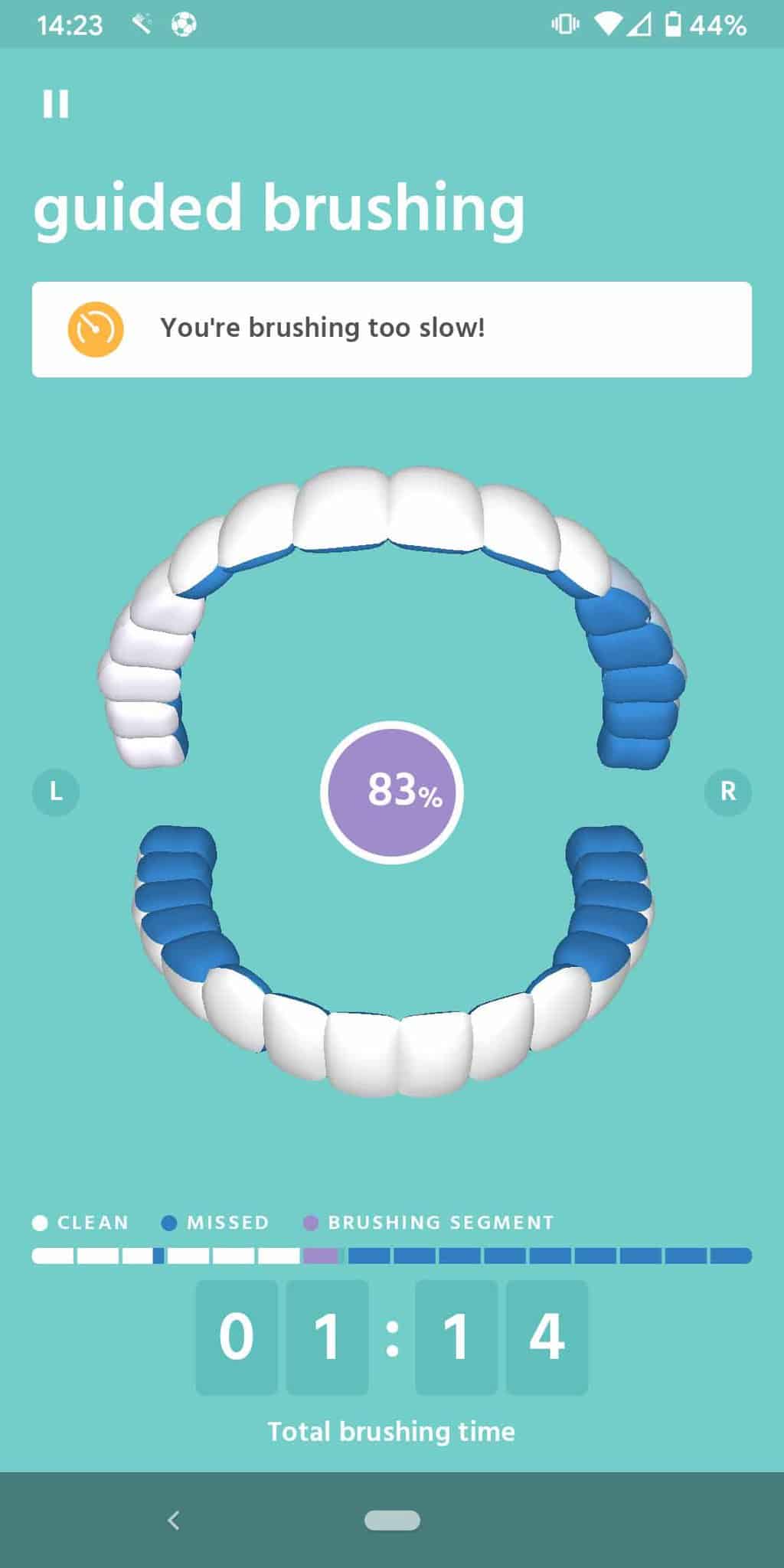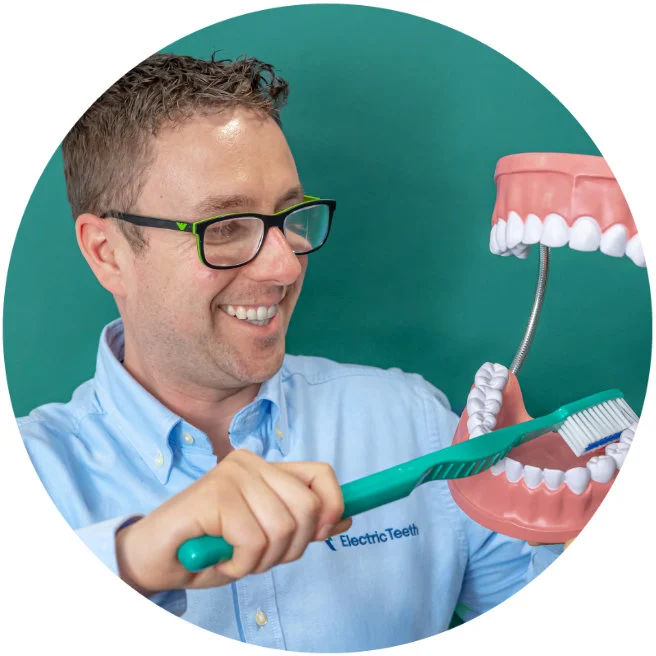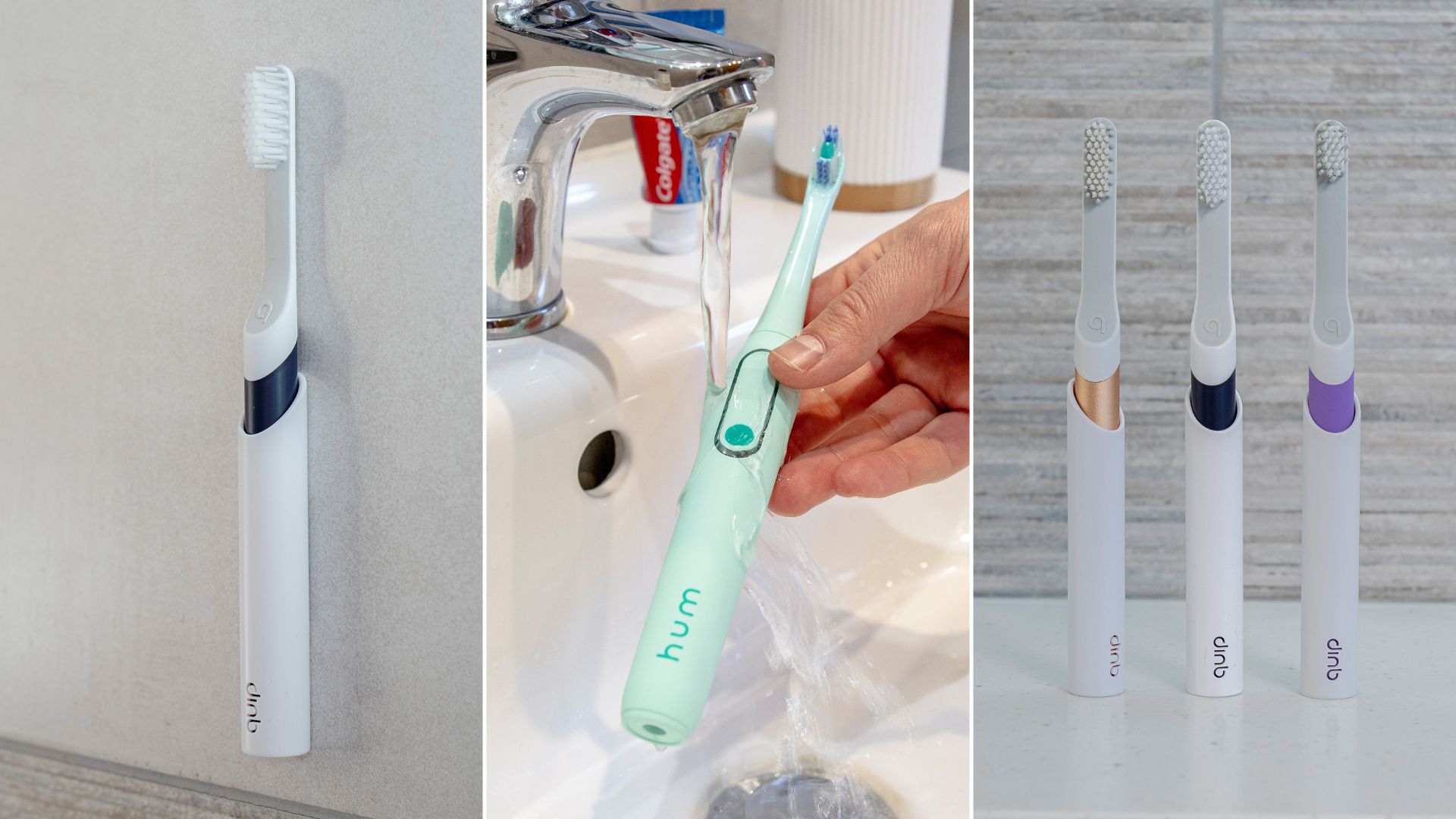
Our choice: Hum Smart Rechargeable
The hum is the toothbrush I would ultimately pick out of these 2 models.
The cleaning action is more powerful and the smartphone app is better.
That said, there is in truth not a significant amount of difference between them. 1 brush might be slightly better at 1 thing and then the other better at something else.

Key differences
With the hum, you have an option powered by 2 x removable AAA batteries and an option with a built-in rechargeable battery.
The rechargeable delivers up to 30,000 strokes per minute compared to the 20,000 of the battery. The rechargeable version also comes with 3 different cleaning modes (deep clean, normal, and sensitive) compared to the 2 (normal and sensitive) available on the battery option.
Both the rechargeable and removable battery options are ‘smart’, with Bluetooth connectivity.
When it comes to Quip, where once it was an option only with removable batteries, there is too a brush with a built-in rechargeable battery.
There is a standard electric toothbrush without Bluetooth, as well as their ‘Smart’, Bluetooth enabled version. Both are available with a removable or built-in rechargeable battery.
You can actually buy the Bluetooth enabled motor that makes the brush smart, and replace the one that comes with Quip's standard electric toothbrush.
For the purpose of this comparison, I will be comparing the removable battery powered hum to the smart Quip toothbrush.
- Handle design/colors
- Quip is the slimmer of the 2 brushes.
- Both have a slightly different shape to the handles.
- Quip is available with a plastic or metal handle.
- Quip Smart comes in 2 colors (white or black) compared to the 3 colors (teal, blue, purple) of the hum.
- The hum has an LED light around the power button.
- Cleaning modes
- The hum has 2 cleaning modes, normal and sensitive compared to the 1 mode of Quip.
- The hum offers up to 20,000 strokes per minute compared to the 15,000 RPM of Quip.
- Brush heads
- The brush head on Quip is about 1/3 larger than that of the hum.
- The bristle configuration is different.
- 2 heads included with the hum.
- Battery
- The hum is powered by 2 x AAA batteries compared to the 1 x AAA battery of Quip.
- The hum shows battery status information within the app. Quip does not.
- Bluetooth technology
- The hum by Colgate app has real-time tracking with visualizations that Quip does not.
- Travel case
- The Quip travel case doubles up as a wall mount.
- The Quip travel case is slimmer.
- The hum travel case can hold 2 brush heads.
- Other
- The hum by Colgate will stand upright on a countertop. The Quip brush does not.
- Quip’s subscription comes with a replacement battery included, Colgate’s does not.
- Quip automatically powers off at the end of the cleaning process.
- Warranty
- Quip comes with a lifetime warranty if you subscribe to brush head refills.
- Quip offers a 1 year warranty if you do not subscribe.
- Colgate offers a 2 year warranty irrespective of subscription status.
- Price
- Smallest of price differences.
- Quip is available for $45 for the plastic handle and $65 for the metal compared to the $49.99 or the hum.
- Colgate’s brush head subscription is $4.99 compared to the $5 of Quip.
These differences are explained at length later in this article. However, you might wish to learn more about each brush being compared. To do so, check out our hands-on reviews:
- hum by Colgate review (this is of the rechargeable variant)
- Quip toothbrush review
Please note. Every effort is made to ensure the key differences listed are correct, but these differences are subject to change without notice. Products and the box contents can be changed without notice and different variants can exist.
Detailed comparison: what’s the difference between the hum by Colgate and Quip smart toothbrush?
Starting with the design of the brush handle, it is immediately obvious that the Quip and hum by Colgate are a little different.
Quip is the slimmer of the 2 brush handles. It has a sleeker profile to it and is much more minimal in its appearance.
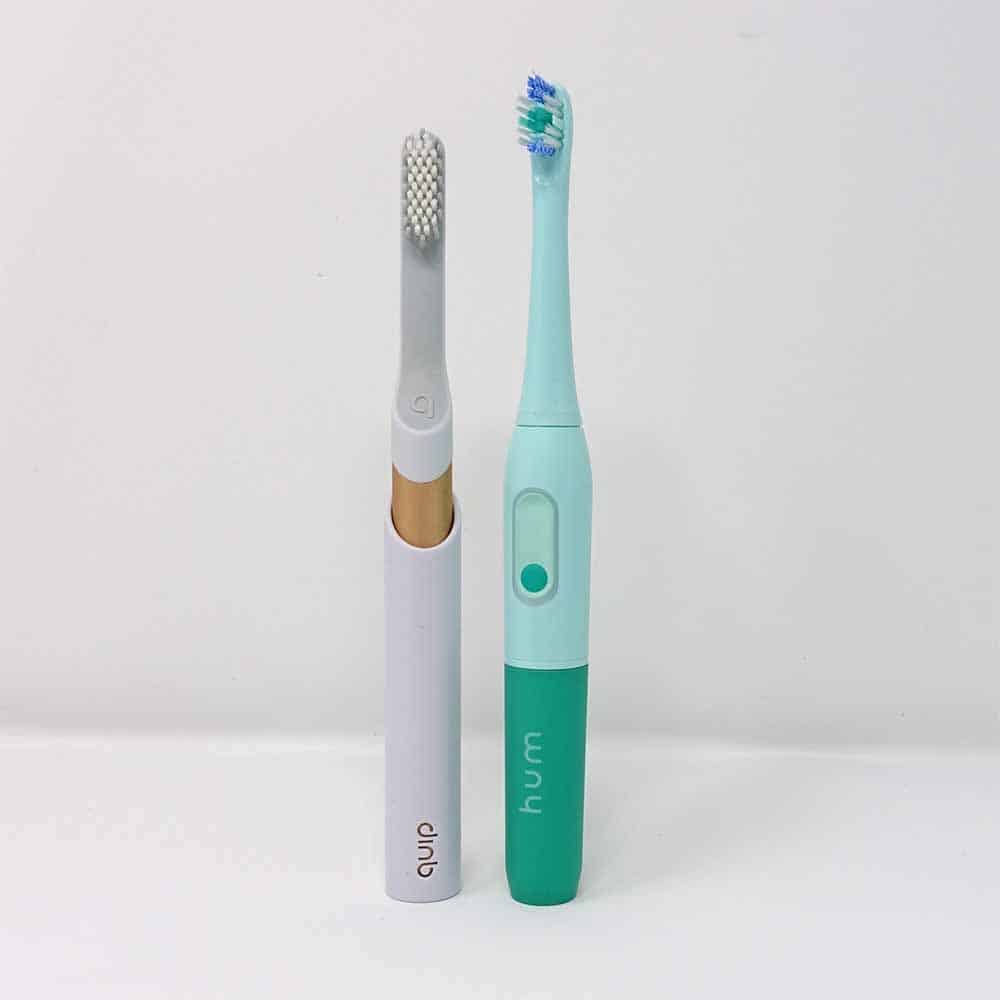
Both brushes have a cylindrical form factor, but the hum is slightly wider at the top of the handle than it is at the bottom. There is a slightly tapered profile to the handle, compared to the consistent width/thickness of the Quip.
The hum will stand upright on a countertop, whereas the Quip brush will not because it has a rounded base compared to the flat base of the hum.
Both have notches on the back of the handles that help stop the handles from rolling if laid flat.
The Quip handle is available in both plastic and metal materials. The plastic option is white in color whilst the metal is black in color.
Hum on the other hand has the same plastic construction but is available in 3 color options, teal (green), blue and purple. On each handle, there are 2 different color tones to make it stand out. The removable battery cap on the lower part of the handle is the darker tone, with the lighter tone at the top.
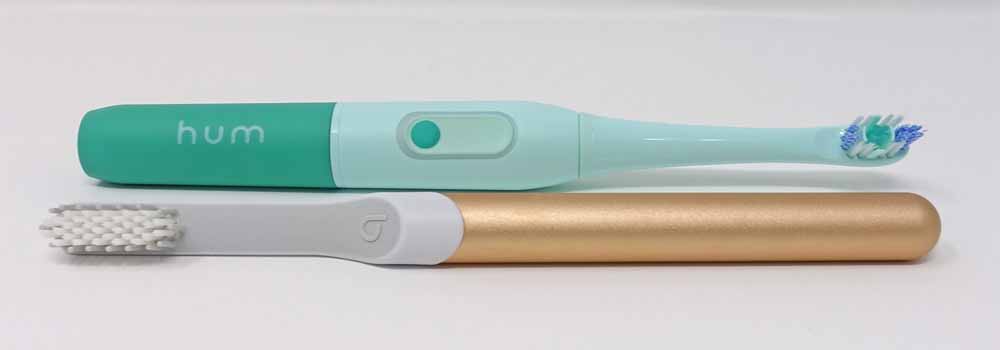
It will be personal preference as to what you prefer. The metal handle of the Quip certainly feels premium, but there is something quite reassuring about the slightly larger handle of the hum, it feels perhaps a fraction more comfortable in hand.
It should be noted that although the ‘smart’ Quip toothbrush comes in just 2 colors, the ‘smart’ motor can be purchased and fitted into different colored Quip handles.
For example, the hands-on photos show the copper colored metal handle that I have actually used because I have fitted a smart motor to it.
Both handles have a single power/function button. The hum’s button is more traditionally placed on the front of the handle, compared to Quips on the lower part of the brush head.
They both do what they need to, but a nice touch with the hum is a thin clear panel/ring around the button that shines different colors, depending on which of the 2 modes are active on the brush.
Unlike Quip that has just 1 mode, the hum has a normal and a sensitive mode.
On the hum, when the normal mode is active, a white light is shone through this clear ring or a pink light if it is set to the more gentle sensitive cleaning mode.
The 2nd cleaning mode is by no means essential, but it is a nice to have as it is less intense than the standard mode.
I am not sure precisely how much difference there is in the brush head movement between the modes. I would suggest somewhere around 30% less powerful.
The hum has a sonic motor that delivers up to 20,000 vibrations/strokes per minute compared to the 15,000 of the Quip.
The difference is noticeable side by side.
When the hum is used on the sensitive mode it feels similar to Quip, but the hum is more powerful on the normal mode. I prefer the more powerful and intense clean of the hum.
Neither are as intense/powerful as a traditional sonic electric toothbrush from the likes of Sonicare for example. Their larger handled brushes do feel like they clean even more effectively.
Linked to how well the brush cleans, is the brush head.
Both brushes have removable brush heads, but there is only 1 style of head available from each brand. Quip comes with 1 supplied, whereas the hum comes with 2 in the box.
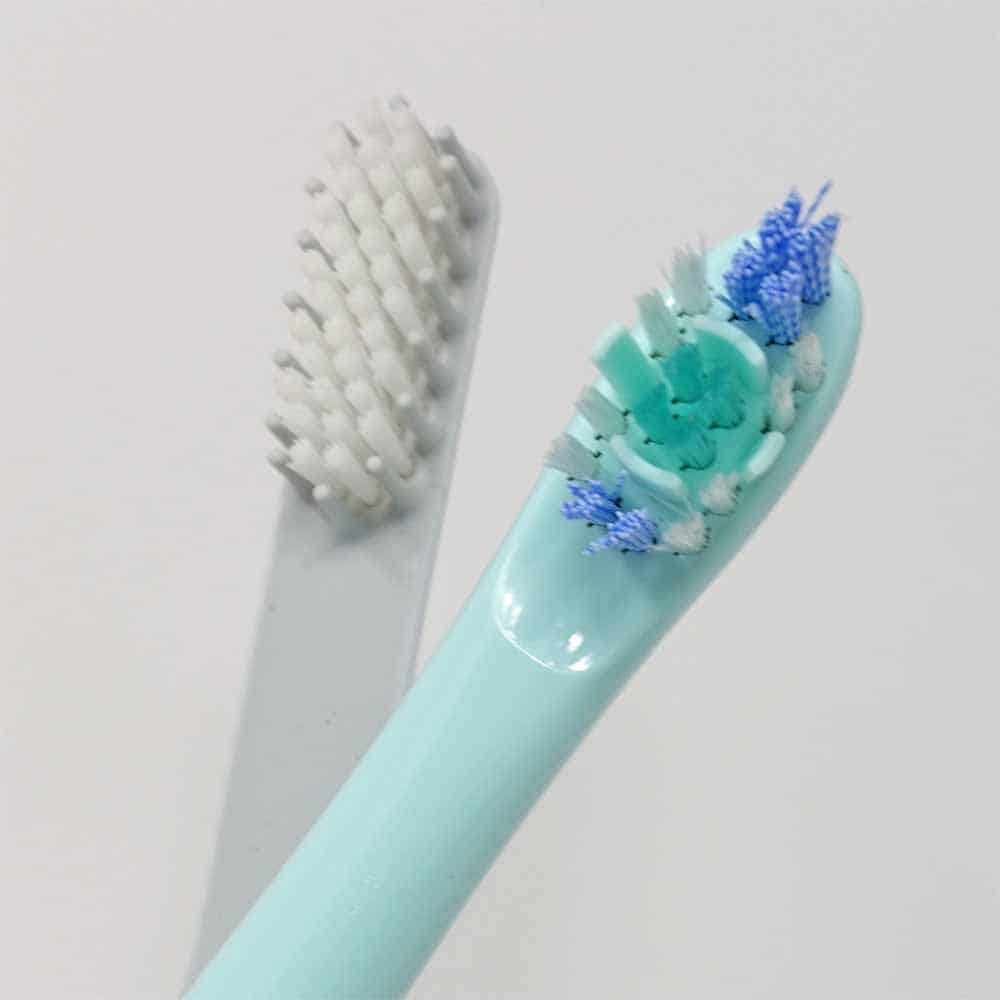
The head on Quip is larger, about one third of the size again compared to the hum.
You can certainly brush more tooth and gum surfaces with Quip at any one time, but the hum’s smaller brush head feels more agile and easier to move around the mouth, particularly at the back where things tend to get a little more cramped.
Both heads are of a similar width. Although Quip has more bristles, they are all the same length, whereas there is more variance with the bristles on the head of the hum toothbrush.
Slightly shorter and thicker silicone or possibly thermoplastic elastomer bristles frame the outer edge of the Quip brush head and are designed to be soft and gentle on the gums.
Both heads have tongue scrapers on the back, which is a very nice touch.
At the end of any brushing cycle, the Quip brush will automatically turn itself off, the same cannot be said for the hum.
Powering the brushes are removable batteries (rechargeable variants of each brush are available).
In the case of Quip, this is 1 X AAA whereas the hum uses 2 x AAA.
The extra power of the hum motor is a bit of an indicator as to the need for double the battery power.
Both are going to surpass 3 months of use, but won’t typically last as long as 6 months.
One of the best approaches is to replace the batteries each time the head is replaced.
If you subscribe to Quip brush heads, a replacement is delivered with the head. This is not the case with Colgate.
Accessing the battery compartment is a little different on both. For Quip, you need to take off the brush head, pull out the motor and reveal the compartment inside the handle.
For the hum, you simply unscrew the lower part of the handle and you gain access to the battery compartment.
Working in favor of the hum slightly here is the fact that within the app a guide to the battery charge level is shown. I have not seen this before on a removable battery toothbrush. At least with the hum you can get a bit of warning when the power is running low.
Both of these brushes offer ‘smart’ features. And to be fair, both do realistically outperform in this respect given their price point.
There are brushes from Sonicare and Oral-B that do not offer such comprehensive connectivity options, and these brushes can cost a great deal more.
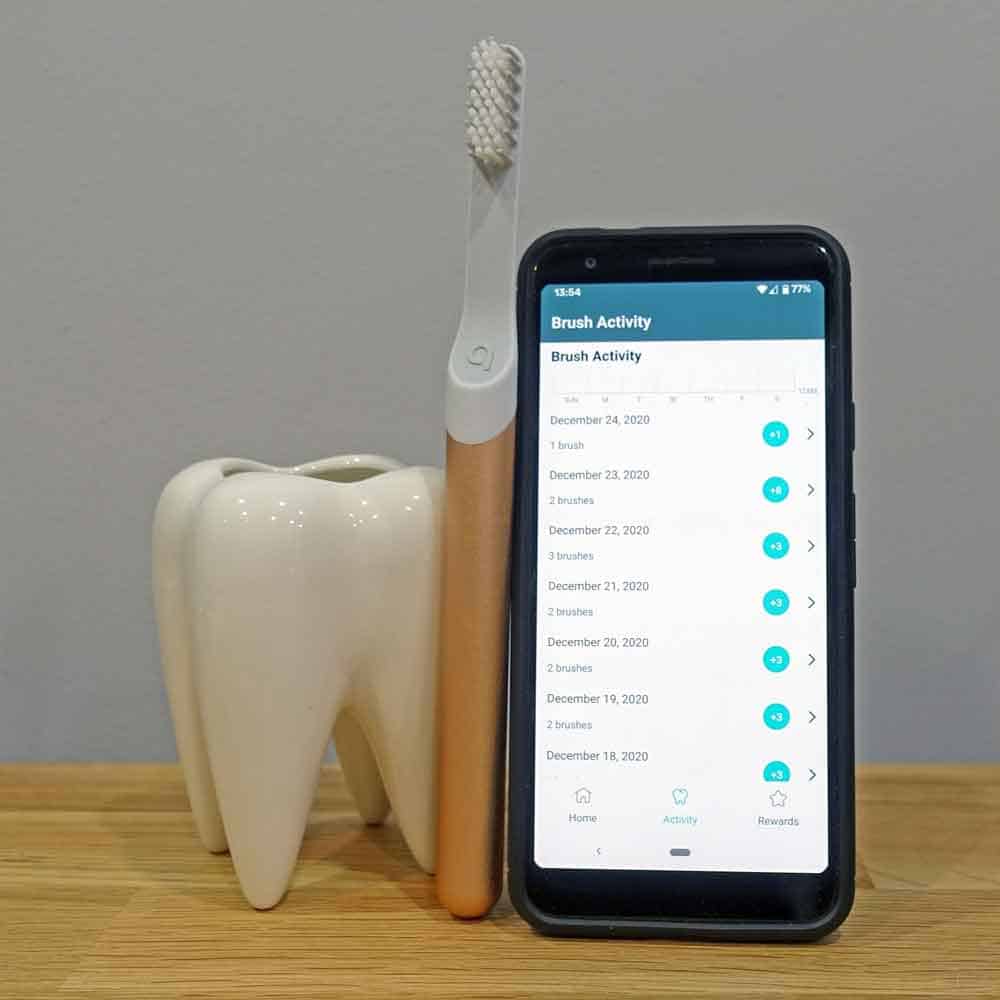
There are many different parts to the apps for both of these models and I could write quite a lot comparing them.
The main thing you need to know is that the Colgate app is a little bit better overall.
The thinking behind smart toothbrushes is that the extra data helps you and me build a better picture of our routine and we can be educated and motivated to do better by the app.
In both instances, the apps are configured to highlight important things to us. Notably, if we are not brushing our teeth as often or for as long as we should.
Whilst I will admit not everyone needs or wants such, you at least have the option with these brushes.
You don’t have to use the smart features. But, particularly in the case of Quip, if you don’t think you will use them, then probably best not to pick this model.
Both are assessing brushing time, frequency and technique to some extent, but it is the hum that can more accurately show areas of the mouth you have and have not brushed.
It has real-time position tracking of the handle. The colors of the teeth within the on-screen visual change to represent those that have and have not been brushed.
It is definitely the more engaging of the 2. It is not perfect and I would argue that premium Sonicare brushes, in particular, are better with their tracking. But, it is fairly accurate and impressive considering the price.
So, if you want the most data and real-time data, then pick the hum.
Both brushes have motivational information included and both offer rewards for brushing routines. The better your brushing technique and routine the more points/rewards you will win.
Points equal prices and overall it works out on average to be approx $1 of rewards you win each month. It does vary on a number of different factors and in truth, you earn a tiny bit more with Quip. You do too have a wider choice of products/rewards you can buy with Quip.
With Colgate, you are really limited to replacement brush heads or new brush handles, whereas with Quip it can go to toothpaste, floss, tote bags, travel cases and even gift vouchers for Target.
Included as standard in the box with both models is a travel case.
The color matched case with the hum is much more traditional in its shape and form factor. It holds 1 x brush handle and up to 2 x brush heads.
Hinged on the left side it opens like a book, has a secure clip to keep the case shut and there are ventilation holes in the case.
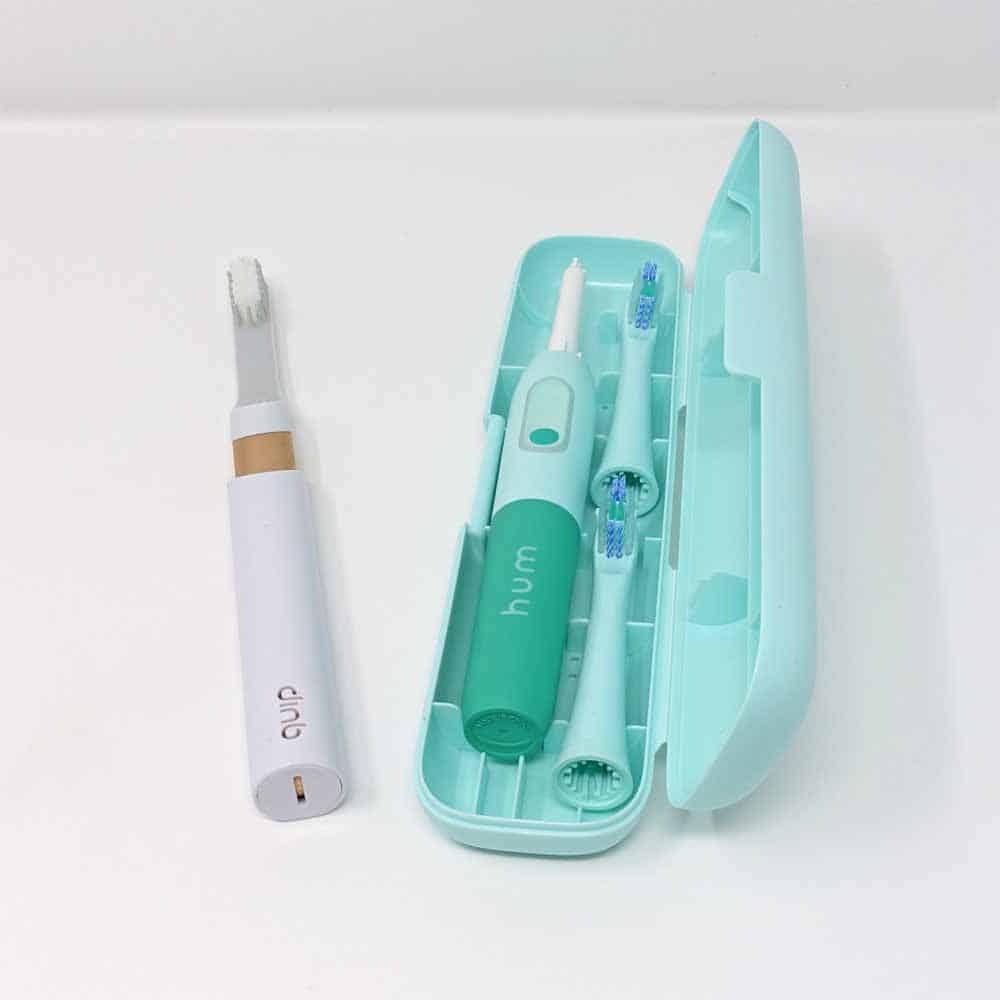
The Quip case on the other hand is more unique and really quite innovative. It is slimmer and doubles up as a wall month for the brush.
A reusable adhesive pad on the back allows this to be stuck to mirrors, tiled walls and other flat surfaces. The handle then slides into the holder to keep it securely out of the way of other things in the bathroom.
It is a fraction larger than the Quip handle itself and slides over the head and the power button to protect it from damage and accidental activation.
The main handle remains exposed, but this smaller profile to the case keeps the size and weight down.
Holes within the holder come case allows for airflow and ensures the bristles on the head can dry if damp.
The last of the differences now and this relates to the warranty that you get with the brushes.
Quip comes with a 1 year warranty if you make a one time purchase of the handle and do not subscribe.
If you do subscribe to brush head refill deliveries ($5 every 3 months) at the time of order, the warranty is extended for as long as you remain subscribed.
With Colgate hum, the warranty is fixed at 2 years irrespective of whether you are subscribed or not.
Does one clean better than the other?
Yes, it is the hum by Colgate that cleans better.
The key reason as to why it cleans better is the additional movements in the brush head. It moves at up to 20,000 times per minute, compared to the 15,000 of the Quip.
The extra movements make it feel like the brush is cleaning better and post clean it feels, to me at least, like the hum has done a better job.
Let me be clear, my testing is by no means scientific. I don’t think the difference would really be considered clinically significant. Nor does choosing the hum over Quip guarantee you cleaner teeth and gums.
I do believe that the smaller brush head is beneficial for moving around the teeth and getting to the harder to reach areas, but others may feel that the larger head is better as it provides more coverage.
One extra positive for the hum is the fact it has a 2nd cleaning mode, not just 1 mode like the Quip.
The extra mode is by no means essential but it at least offers a lower powered sensitive mode for those who might find the normal mode a little too intense.
The sensitive mode of hum is akin to the only mode on Quip, whereas the normal cleaning mode on the hum is quite a bit more powerful.
It could also be argued that the real-time tracking offered by the hum will allow you to clean the teeth better as you can more accurately see what areas of the mouth you have and have not successfully brushed.
When used in real-time you are guided in a way that makes your brush evenly and as correctly as possible to be able to move onto the next section. This is something that is simply not possible with the Quip Smart.
Ultimately with hum you can be more assured you have achieved the best clean you could.
Is one better priced than the other?
No, not really, although there is potentially a very small difference, subject to the variants you opt for and whether you subscribe or not.
Quip is available for $50 with a plastic handle as is the hum by Colgate.
However, Quip also offers a metal handled option that costs $65, an extra $15 over the plastic option.
Both Quip and Colgate can be purchased with or without a subscription.
If you subscribe to Quip, a replacement brush head and 1 x AAA battery is dispatched every 3 months for $5.
Colgate offers a 3 monthly brush head subscription for $0.01 less, just $4.99. But,
Colgate does not include replacement AAA batteries, so arguably the Quip subscription is better value.
As a rough guide, if you subscribe, over 3 years Quip will cost $105 or $0.10 per day whilst the hum will cost approximately $116 or $0.11 per day (including the cost of batteries).
If you choose not to subscribe, the heads can be purchased individually from Quip for $5 each or as a pack of 2 with Colgate for $9.99.
The only thing with Quip is that the postage cost is higher for buying a single brush head, the emphasis is to subscribe.
The other slight advantage of Colgate is that it is sold via other retailers and not just direct. Therefore you have a little more choice and potential price competition.
Quip is beginning to be sold elsewhere, but the subscription is still direct.
With both models, there are possible cost savings possible via the app and the rewards you earn within this. There are too many variables to really detail it here, but as a general rule, you earn around $1 per month if you brush twice a day with each app.
This financial reward can be redeemed against items you may buy anyhow to help keep the cost down.
Conclusion
|
Our Choice

|
Our Choice

|
|
|---|---|---|
| Electric Teeth Rating |
|
|
| Amazon | $23.7 | $34.99 |
| Walmart | $24.97 | - |
| Quip | - | View price |
Trying to really decide between these 2 brushes is not that simple.
Where the sleeker design of the Quip toothbrush is more appealing, the hum becomes the more desirable option because of its app.
Overall, I do believe that the hum just takes the edge. This is primarily because of the 2nd cleaning mode, the slightly more powerful motor and the slightly more capable app.
Both of these brushes feel like a bit of a crossover between a manual toothbrush and an electric toothbrush. Neither gives quite the same cleaning experience as the Oral-B Smart 1500 or the Sonicare ProtectiveClean 4100 does. This is something to be aware of if you are an existing electric toothbrush user.
Used correctly, either will help you maintain a good standard of oral health.



